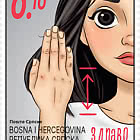Fauna
Bosnia and Herzegovina is rich in high diversity of plant and animal species, ecosystems and genetic diversity among species, due to its specific geographical location and pronounced different climatic zones from north to south. It is characterized by a large number of refuges and habitats that favored the conservation of species during the last ice age, which began in Europe 2.6 million years ago and lasted until 11,700 years ago. In Bosnia and Herzegovina, 29 indigenous species of reptiles have been registered, and there are two more registered non-indigenous species of turtles originating from America and Asia.
Ablepharus kitaibelii Bibron & Bory de Saint-Vincent, 1833 - short-legged lizard
Ablepharus kitaibelii or short- legged lizard inhabits southeastern Europe, western and central Turkey. It is the rarest reptile in Bosnia and Herzegovina and was found only in the area of eastern Bosnia and Herzegovina, near Ustikolina.
The short-legged lizard grows up to 15 cm. Their eyelids are immobile which distinguishes them from other lizards in this area. Females are larger than males. It is copper brown to a bright olive-green color, with darker sides. Males are usually darker than females.
It inhabits arid areas, including the slopes of the southern exposure, meadows, thickets and clearings in the forest. It is usually located near the ground cover such as leaves, dead trees, stones, shrubs and other vegetation.
It is a strictly protected species according to the Decree on protected and strictly protected wild species of the Republic of Srpska.
Hemidactylus turcicus Linnaeus, 1758 - Mediterranean house gecko
Hemidactylus turcicus or Mediterranean house gecko is widespread around the Mediterranean basin and in western Asia. It is also found in certain parts of continental Europe and on numerous islands in the Mediterranean. In Bosnia and Herzegovina, this species has been recorded in the Mediterranean area, from Ljubuški through Čapljina and Mostar, across Popovo polje to the foot of Mount Orjen.
Sizes are about 10 cm, and sometimes longer. They are very agile and active animals, especially at night. They have sticky surfaces on the toes, and each finger ends in a claw. They are often pale and pink-colored skin, covered with scales resembling warts. They have dark, irregular spots on their backs. They have the ability to change body color, relative to habitat color. Their eyes are large, with elongated vertical pupils.
They inhabit warmer, coastal areas. They are sometimes widespread in the interior of the continent along river valleys. It is an extremely adaptable species and inhabits rocky areas, coastal areas, cliffs, caves, and is common in urban areas.
Due to its distribution and adaptability, the species is not included in the Decree on Protected and Strictly Protected Wild Species of the Republika Srpska.
Author: Tanja Kuruzović
Collaboration: Ana Ćurić, Senior Expert Associate for Biodiversity - Zoologist, Republic Institute for the Protection of Cultural, Historical and Natural Heritage
Publisher: Post of Srpska a.d. Banja Luka
Bosnia and Herzegovina - Republic of Srpska - Recommended stamp issues
WOPA+ recommended stamp issues
| Avatar - Fire and Ash |
| Issued: 03.12.2025 |
| ›New Zealand |
| 50th Anniversary of the Founding of the 24th November Bar Scout |
| Issued: 24.11.2025 |
| ›Montenegro |
| Krisjanis Valdemars |
| Issued: 02.12.2025 |
| ›Latvia |
| Sign Language - Good |
| Issued: 02.12.2025 |
| ›Bosnia and Herzegovina - Republic of Srpska |
| In Memory of the Fallen and Murdered on October 7, 2023 |
| Issued: 08.10.2025 |
| ›Israel |
| Annual Collection Folder (New York) |
| Issued: 05.12.2025 |
| ›United Nations |
| Year Set |
| Issued: 24.11.2025 |
| ›Isle of Man |
| Shipping in the 17th and 18th Centuries - Peat Shipping |
| Issued: 05.12.2025 |
| ›Netherlands |















































